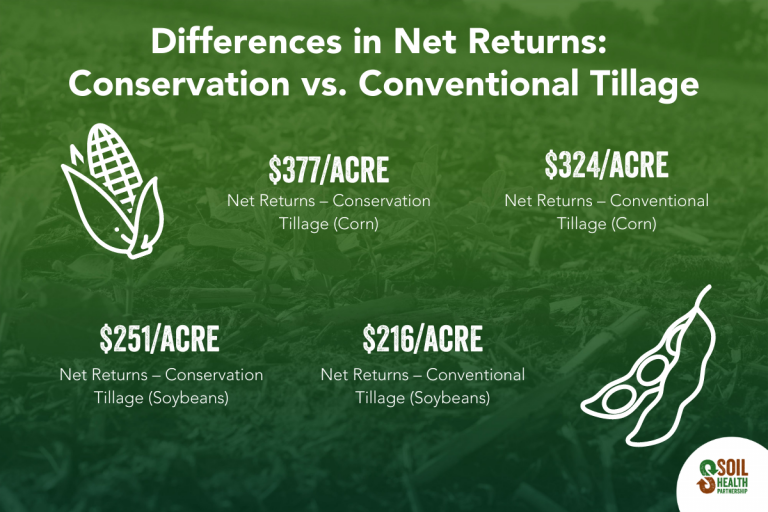This blog was originally published by Dr. Maria Bowman on Soil Health Partnership’s blog.
When farmers consider implementing a soil health or conservation practice on their farm, one question they inevitably ask is: what will the financial impacts be?
In an effort to answer this question, we recently released Conservation’s Impact on the Farm Bottom Line — a report developed in partnership with Environmental Defense Fund and the agricultural accounting firm K·Coe Isom — to better understand the benefits, opportunities and limiting factors associated with common conservation practices.
One of the key findings from this report is that farmers can save money as part of a transition to conservation tillage. In a world where the farm economy can be uncertain and a changing climate can create unforeseen weather challenges, reducing costs of production by tilling less may be one way for farmers to improve profitability.
Net returns are higher in conservation tillage systems
In our detailed analysis of the financial records of seven Midwest grain farmers, we found that fields using no-till or some form of conservation tillage (for example strip-till or reduced tillage, depending on the farmer) achieved higher net returns per acre than conventionally tilled fields. In corn, this was a difference of $53 per acre and, in soybeans, the difference in net returns was $35 per acre.

Graphic showing differences in net returns for conservation and conventional tillage. A detailed breakdown of the financial records for farmers in our study can be found here. (Photo credit: Soil Health Partnership)
The difference in net income for conservation tillage systems is driven by lower costs
Our analysis showed that improvements in net returns for systems using conservation tillage were driven by a reduction in overall costs. On average, expenses for corn fields under conservation tillage were more than $40 per acre less and nearly $100 per acre less for soybean fields (both as compared to conventionally tilled fields).
Farmers saved on fuel, repairs, and equipment expenses — overall making conservation tillage systems more profitable than conventional tillage systems. For one of the farmers included in the study, Brian Ryberg of Minnesota, the shift toward conservation tillage impacted profitability by:
- Reducing field passes by 25%, leading to a 60% decrease in fuel consumption.
- Saving approximately $20 per acre when his cover crops are well-established and he can no-till soybeans.
- Cutting the number of tractors — and related equipment hours — in half.
Digging in
While we are not the only group to highlight the impact of conservation tillage on the farm bottom line, we were excited to see that trend confirmed in our research.
Even after adding cover crop costs, fields using conservation tillage and cover crops together had similar or lower per-acre costs than conventionally tilled fields. These data continue to show how soil health and farm profitability can go hand in hand — for everyone’s benefit.
Make sure to check out the full report, Conservation’s Impact on the Farm Bottom Line, and read up on Brian Ryberg’s conservation tillage experience to learn more.









